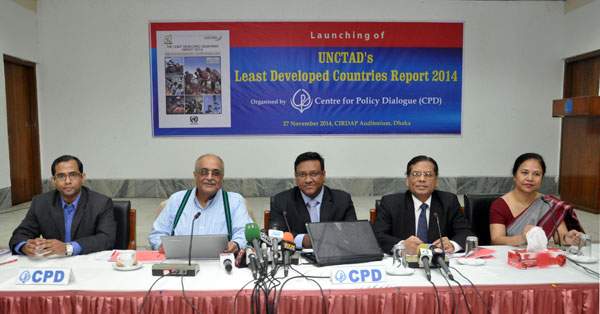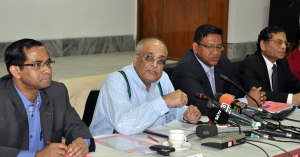Bangladesh’s graduation from the LDCs
Reducing economic vulnerability and enhancing human assets to rise above LDC status

Bangladesh needs to pursue economic and human development simultaneously to graduate from the LDC status as well as meet the requirements of the post-2015 development agenda.
Greater emphasis should be put in generating income and employment, structural transformation through increased industrial productivity as well as good governance in order to reduce economic vulnerability that persistently hold back LDCs including Bangladesh from generating enough momentum to graduate.
The observations emerged from a media briefing on the occasion of the global launch of UNCTAD’s LDCs Report 2014 subtitled “Growth with Structural Transformation: A Post-2015 Development Agenda” at the CIRDAP auditorium on Thursday 27 November 2014.
CPD Research Fellow Mr Towfiqul Islam Khan presented the report highlights that recommended LDCs to prioritise resource mobilisation for public and private investment, industrial and sectoral policies to channel resources into most productive sectors and activities and macroeconomic policies which foster economic growth.
Underscoring Bangladesh’s status amongst the LDCs, Mr Khan mentioned that despite the LDCs excelled in economic growth during the last decades, quality of livelihood did not significantly improve which, in turn, undermined progress towards achieving the MDG targets.
[box type=”tick”]Presentation on the report[/box]The international community must learn from this failure called ‘the LDC paradox’, noted Mr Khan quoting the report that considers the LDCs as battlegrounds for the Post-2015 Development Agenda and the Sustainable Development Goals (SDGs). Achieving targets for these goals in the LDCs would indicate success.
 Explaining the LDCs’ drawbacks, Dr Debapriya Bhattacharya, Distinguished Fellow, CPD said that Bangladesh’s development amongst the LDCs is remarkable due to improved growth, remittance influx, enhanced food security and resilience to environmental disaster etc. But the country lags behind in primary areas such as income and employment generation, diversification of existing exportable items, low per capita income due to large population etc.
Explaining the LDCs’ drawbacks, Dr Debapriya Bhattacharya, Distinguished Fellow, CPD said that Bangladesh’s development amongst the LDCs is remarkable due to improved growth, remittance influx, enhanced food security and resilience to environmental disaster etc. But the country lags behind in primary areas such as income and employment generation, diversification of existing exportable items, low per capita income due to large population etc.
As a result, Bangladesh cannot go beyond the low wage-low productivity-low income cycle, noted Dr Bhattacharya. He, however, added that becoming a middle income country also does not mean graduating from the LDCs group because it requires improving on social indicators which many LDCs failed to achieve despite generating high income and growth through exporting natural resources and tourism promotion.
In this regard, Professor Mustafizur Rahman, Executive Director, CPD underscored that Bangladesh cannot meet the post-2015 goals without addressing human and economic development altogether because development in the 21st century is not linear, there are qualitative changes in the age of globalisation.
The briefing was followed by a Q&A session with the senior researchers including Dr Khondaker Golam Moazzem, Additional Research Director and Ms Anisatul Fatema Yousuf, Director, Dialogue and Communication, CPD.



